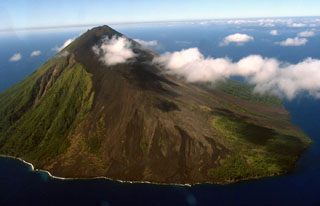Report on Lopevi (Vanuatu) — December 2002
Bulletin of the Global Volcanism Network, vol. 27, no. 12 (December 2002)
Managing Editor: Richard Wunderman.
Lopevi (Vanuatu) Anomalous SO2 emissions detected by satellite in December 2002 and January 2003
Please cite this report as:
Global Volcanism Program, 2002. Report on Lopevi (Vanuatu) (Wunderman, R., ed.). Bulletin of the Global Volcanism Network, 27:12. Smithsonian Institution. https://doi.org/10.5479/si.GVP.BGVN200212-257050
Lopevi
Vanuatu
16.507°S, 168.346°E; summit elev. 1413 m
All times are local (unless otherwise noted)
Satellite data interpreted by Simon Carn indicate that anomalous degassing may have begun from a volcano in Vanuatu in mid-December 2002. SO2 signals were noted in data from both the Global Ozone Monitoring Experiment (GOME) on the ERS-2 satellite and the Earth Probe Total Ozone Mapping Spectrometer (TOMS). Although GOME is more sensitive to SO2 than TOMS, its spatial resolution is very poor, so distinguishing the source of emissions between Ambrym and Lopevi is impossible using the available imagery.
However, on 14 December John Seach noted a strong sulfurous smell on the W side of Ambrym caldera. The wind was blowing from the direction of Lopevi at the time, and white emissions were noticed on Lopevi's active crater on the NW flank of the volcano. Seach did not note unusual emissions from Ambrym during his 11-15 December 2002 visit, so the editors are attributing this activity to Lopevi unless other data are found that identify Ambrym as the source.
GOME data indicate SO2 emissions over Vanuatu on 13, 19, 22, and 25 December 2002, then again during 4, 7, 11, 14, 17, and 20 January 2003. Data are only collected every third day, so degassing could be continuous, with a possible lull in late December. After 11 January GOME signals became very weak. TOMS data also indicated SO2 originating from the region on 19, 21, and 25 December, and again during 4, 5, 6, 8, 9, 10, 11, and 12 January, with nothing really evident since then. On a couple of days, particularly 4 January, the anomaly seen in TOMS imagery seemed to be originating from Ambrym.
The SO2 mass detected by TOMS immediately E of Lopevi and Ambrym on 8 January was estimated at less than 5,000 tons, a low value. Combining the two datasets indicates that the most significant SO2 emissions occurred around 25 December 2002 and 4-11 January 2003. After mid-January the activity seemed to be tapering off.
Geological Summary. The small 7-km-wide conical island of Lopevi, known locally as Vanei Vollohulu, is one of Vanuatu's most active volcanoes. A small summit crater containing a cinder cone is breached to the NW and tops an older cone that is rimmed by the remnant of a larger crater. The basaltic-to-andesitic volcano has been active during historical time at both summit and flank vents, primarily along a NW-SE-trending fissure that cuts across the island, producing moderate explosive eruptions and lava flows that reached the coast. Historical eruptions at the 1413-m-high volcano date back to the mid-19th century. The island was evacuated following major eruptions in 1939 and 1960. The latter eruption, from a NW-flank fissure vent, produced a pyroclastic flow that swept to the sea and a lava flow that formed a new peninsula on the western coast.
Information Contacts: Simon A. Carn, TOMS Volcanic Emissions Group, Joint Center for Earth Systems Technology (NASA/UMBC), University of Maryland Baltimore County, 1000 Hilltop Circle, Baltimore, MD 21250, USA (URL: https://jcet.umbc.edu/); John Seach, PO Box 16, Chatsworth Island, NSW 2469, Australia (URL: http://www.volcanolive.com/).

